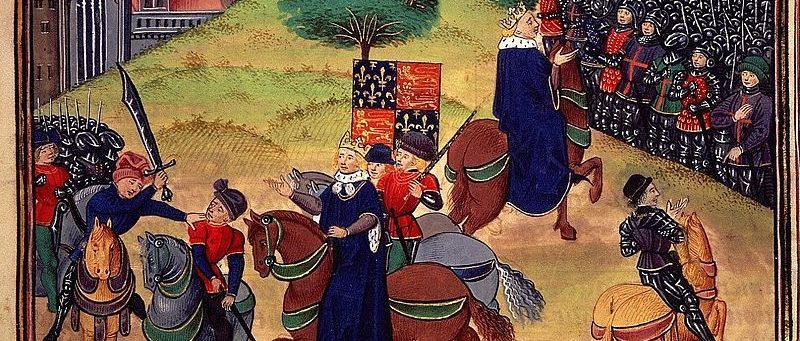The Peasants Revolt
Posted on 10th January 2021
In June 1348 at Melcombe Bay in Dorset, the Black Death arrived upon the shores of England. It had already ravaged much of Europe and now in little over a year its scourge would kill almost half the population and tear at the very fabric of English society in a way that little else could. Land and the labour required to work it was the source of wealth in medieval England and the social hierarchy was rigid and supposedly ordained by God. There was little scope then for social advancement and the peasantry as serfs were obliged to work on the land of their liege lord but with labour suddenly scarce that framework was to be broken, and as it transpired irreparably so.
The death of so many meant peasants could now charge accordingly for their labour. If a landowner was unwilling to pay then so be it, but his cows would go un-milked, his fields would remain unploughed, and his crops would not be sown while the peasant would simply offer his services elsewhere. Not that the landowning class were willing to accept this new reality without a fight.
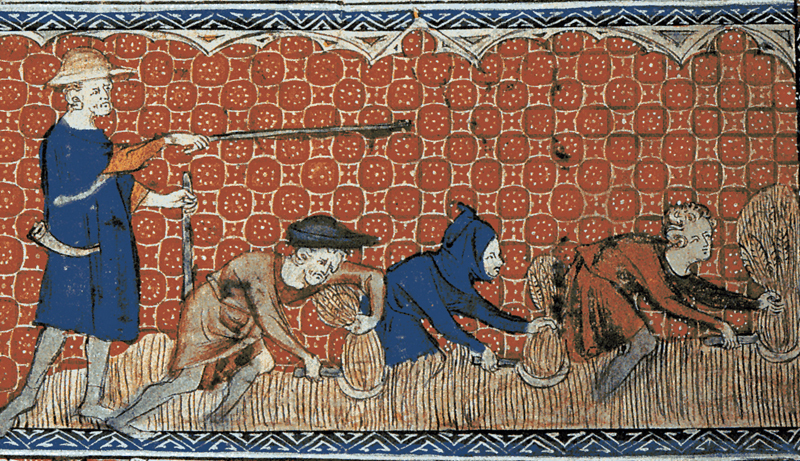
On 18 June 1349, Edward III passed into law the Ordinance of Labour which introduced price controls and fixed wages to pre-plague levels. It made little difference and those who were forced to work did so only reluctantly causing John Gow, the poet, and friend of Geoffrey Chaucer, to write despairingly: “They are sluggish, they are scarce, and they are grasping. For the very little they do they demand the highest pay.”
Two years later Parliament passed the Statute of Labourers intended to reinforce the previous Ordinance by stipulating exactly what farm labourers, shepherds, and artisans such as cobblers, carpenters, and blacksmiths could earn. Workers could not demand more, and employers were not permitted to pay more, nor were they allowed to employ excess labour or provide alms to the poor.
To combat inflation price controls remained in force and to increase the pool of available labour everyone under the age of sixty was required to work but as there were few records with which to determine a person’s age and given the short life expectancy of the time this meant almost everyone. But the new laws, enforced by local officials were in fact more honoured in the breach as market forces prevailed and wages would in fact more than double over the coming decades.
The Black Death had also provided opportunities for those fortunate enough to survive and would otherwise have remained poor to acquire through inheritance small fortunes of their own. One such man was Clement Paston, a yeoman farmer, or plain peasant from Norfolk, who inheriting land and money from deceased relatives invested it wisely putting his family on the path to respectability and to becoming the eventual owners of Caister Castle.
Such men would form the backbone of rural England in the decades following the Black Death and it was a status they were willing to defend, and so it was to prove in the summer of 1381.
Richard II, the son of the deceased Black Prince, the hero of the Battle of Crecy, had been crowned King of England on 16 July 1377, following the death of his grandfather Edward III who’s long fifty year reign had been brought to a close the previous month.
Even at ten years of age much was expected from the scion of such great men, but it did not augur well that England was to be ruled by a child especially as during the period of his minority the country was to be governed by a Royal Council under the guidance of his uncle John of Gaunt, a man little trusted and even less liked.
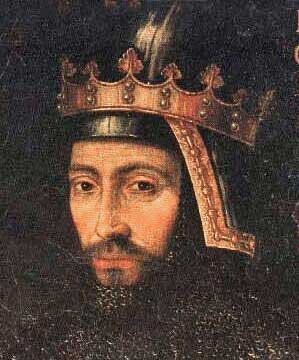
Believed to be as ambitious as Lucifer many feared that John of Gaunt would use the opportunity of the King’s youth to seize the crown for himself and it is perhaps indicative of the power, he already wielded that he chose not to. The young Richard was King by divine appointment after all, and there was little mood among the nobility for dispute and any fears that a child on the throne would result in political and dynastic turmoil were soon allayed.; the unpopular John of Gaunt may have ruled with a rod of iron but power for him was always a case of personal enrichment something he pursued with gusto - the challenge to Richard’s reign when it came would be from an unexpected source.
England was at the time in the midst of the Hundred Years War with France which was proving increasingly burdensome not only on the nation’s finances but also its manpower and resources. The money required to finance the ongoing conflict could only be raised from among those able to pay, or the very village elite that had come to dominate rural life since the passing of the plague years.
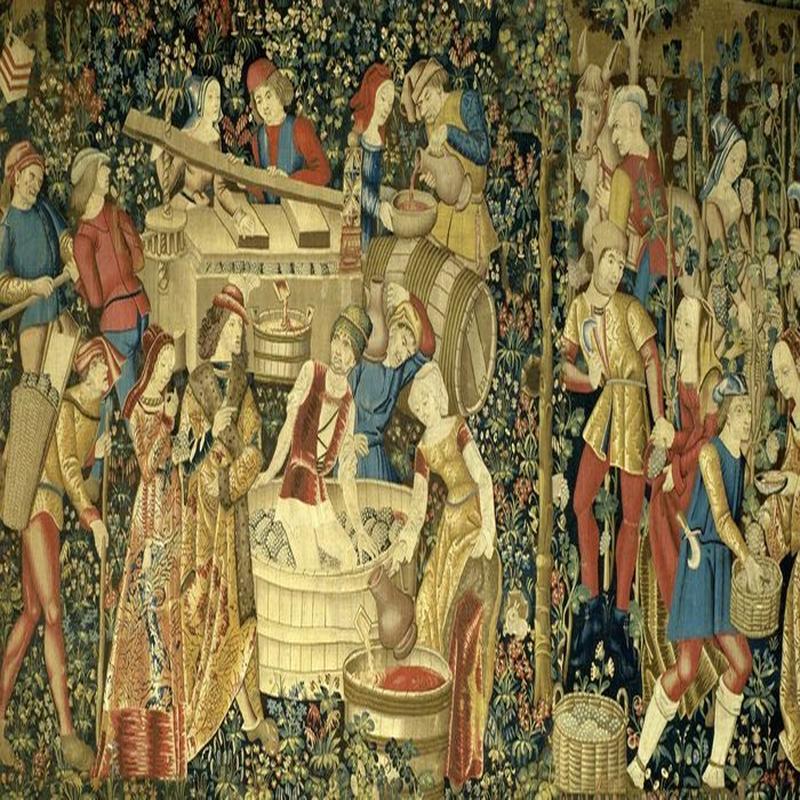
Traditionally tax had been imposed on the property and goods of the individual, but this had proved incapable of compensating for the post-plague slump and providing the finance required for the war in France. A new and more productive form of taxation was required and so a poll tax was levied at a fixed rate of a groat, or 4d, on every person aged 15 and over able to pay regardless of wealth and income. It had first been imposed by John of Gaunt in 1377 during the dying days of Edward III’s reign. It had proved so unpopular that many people removed themselves from the tax register where possible and as a result it garnered only a further £22,000. When it was reintroduced in March 1379, it raised only £18,000.
In November 1380, Simon Sudbury in his capacity as Lord Chancellor announced before Parliament that £160,000 was required in extra taxes to make up for a shortfall in public finances. This time it would be levied at an exorbitant 12d, or four times the previous amount and the age of liability was lowered to 14. Unsurprisingly tax evasion soared with entire villages in Essex and Kent refusing to pay or simply packing up their goods and disappearing into the woods.
The three men who were seen as most responsible for the imposition of the poll tax, John of Gaunt, Archbishop of Canterbury Simon Sudbury, and Lord Treasurer Robert Hales were already loathed for their corruption and greed. Those who had amassed small fortunes of their own in the wake of the Black Death were damned if they were going to give them up to the likes of them. Gaunt, Sudbury, and Hales were no less determined to collect the new tax and to do so with a vigour that had previously been lacking.
In March 1381, Commissioners were despatched to enforce compliance with the poll tax, they were not well received. Peasants suddenly became hard to find, villages had been abandoned, and when people did gather to be assessed as ordered they did so reluctantly and in a mood of non-compliance.
Having established himself at Brentwood in Essex on 30 May Commissioner John Bampton ordered representatives of nearby villages to attend upon him and pay the tax owed. That they turned up armed did not augur well. Led by Thomas Baker from the village of Fobbing the peasants refused to pay and when Bampton demanded they do so they attacked killing three of his clerks. Fearing for his own life Bampton was quick to flee later reporting the incident to Robert Belknap, the Chief Justice of the Court of Common Pleas, who decided to investigate for himself.
Belknap did not travel alone but took the precaution of providing himself with an armed escort only to find the area in such a state of uproar that they counted for little. He was taken prisoner and told that not one of them, would pay even a penny of this iniquitous tax before being forced to witness the beheading of six of his guards. He was then released on the promise never to return. News of Belknap’s humiliation quickly spread, and more tax resisters soon emerged – the Peasants’ Revolt had begun.
But the events at Brentwood were not merely an explosion of pent-up frustration and rage or the violent impulse of unsophisticated wild-eyed illiterates. Indeed, in its initial stages at least the Peasants’ Revolt was notable for its absence of peasants. These were educated men, small landowners and craftsmen, low-level village officials such as the Reeve and the Bailiff, those who had something to lose, the village elite. Among those who are known to have participated are Sir Thomas Raven, a Member of Parliament and Bailiff of Rochester Castle, John Mocking, a London Wine Merchant, John Sumner from the village of Manningtree in Essex (notorious as the birth place of the Witch-finder General) who owned property valued at over 400 marks, or more than £150,000 in today’s money, and Robert Pearce, a local landowner also from Manningtree. There were of course others who were scoundrels such as Thomas Wootton, a soldier who had been paid £30 in advance to fight in France but would instead desert to join the rebels, and Richard Scott, a conman and thief who took part merely to plunder. Evidence also suggests that the Peasants’ Revolt was not as spontaneous as has often been thought.
Although overland communications were poor with few good roads river traffic was commonplace while the better-off among the rebels, of whom there were many as we have seen, had horses and were able to travel far and wide spreading the message of revolt.
The rebels also had a system of communications via coded messages which read out in taverns and town squares were eagerly anticipated. One such message was the following:
“John Shep, sometime St Mary Priest of York and now in Colchester, greeteth well John Nameless and John Miller and John Carter and biddeth Piers Plowman to go to his work and chastise well Hobb the Robber.”
Translated, John Shep was a New Testament reference, the St Mary Priest of York was John Ball, John Nameless was everyman, John Carter and John Miller craftsmen and trades people, Piers Plowman, alluded to the legend of Robin Hood, while Hobb the Robber was another pejorative term fort the Lord Treasurer Robert Hales.
The people understood well enough, they were primed, and they were ready. They had objectives, their appeal was to the King, and their demands were for justice.

John Ball was born in St Albans around 1338 and had already achieved some notoriety as an itinerant critic of the Church and dissident priest whose sermons condemning the wealthy and corrupt representatives of Christ found a ready and receptive audience. Known as the St Mary Priest of York for reasons that remain unclear his outspoken views neither went unnoticed nor unpunished and he was to be imprisoned many times by the Church Authorities. He was also accused of being a follower of John Wycliffe and a Lollard propagandist for which he was excommunicated in 1366. Banned from preaching in Churches or on any Church property he took his message directly to the people addressing them at markets, in roadside taverns, anywhere they gathered in numbers. He even preached in graveyards outside the Church as worshippers left religious service. His run-ins with Simon Sudbury, the Archbishop of Canterbury were many and he was in fact in prison when the Peasant’s Revolt broke out. It wouldn’t be for long, and he was soon giving eloquent voice to the aims and hopes of those who were his adherents. The French chronicler Jean Froissart recounts a typical John Ball peroration:
“Good people, things can never go right in England until goods are held in common and there are no villeins and gentlefolk, but we are all one and the same. In what ways are those we call lords greater masters than ourselves? They are clad in velvet and ermine while we go dressed in coarse cloth. They have the wines, the spices, the good bread; we have the rye, the husks of straw, and we drink water. They have shelter and ease in their fine manors, and we have hardship and toil, the wind and the rain in the fields.”
Froissart also tells us that the Archbishop of Canterbury would imprison John Ball for two or three months at a time but would have done better to have had him executed. But he had scruples, apparently.
Following the events at Brentwood and Fobbing the situation quickly began to spiral out of the Authorities control as it became clear that this was no localised outburst of ill-considered anger but a well thought out campaign of political and social defiance with those known to have colluded with the Commissioners or thought to be untrustworthy being decapitated and their heads stuck on poles as a warning to others. At the village of Cogglesall for example, they executed the local tax collector before ransacking his house and burning the manorial rolls. They then travelled five miles to nearby Cressing Temple owned by the Knights Hospitaller, an Order run in England by Sir Robert Hales, setting it alight. Its large barns and storehouses were left intact however, their stocks of food and wine distributed among the rebels.
In the meantime, the town of Chelmsford was attacked while rebels under Abel Kerr assailed Lesnes Abbey burning it to the ground as the monks fled in panic.
On 3 June, a known tax resister Robert Belling accused wrongly of being a runaway serf by Sir Simon Burley was imprisoned in Rochester Castle. He soon became a cause celebre and three days later the Kentish rebels marched on the Castle determined to release him. The formidable Rochester Castle which during the Baron’s War had resisted siege for seven weeks fell in a day. It was an indication of the degree of intimidation the rebels could now bring to bear and the support they had even among those who were expected to oppose them.
Wat Tyler must have distinguished himself during the storming of Rochester Castle as the following day in Maidstone where John Ball had just been released from prison, he was chosen leader of the rebellion by popular acclaim.
Despite being one of the most iconic names in English history little is known of Wat Tyler, some believe he was a soldier of fortune recently returned from abroad or was spurred on to avenge some personal sleight or imposition. We do know from his name that he was a roof tiler by profession and a man who could stamp his authority on a movement of disparate rebels by force of personality alone.
On the same day as Wat Tyler was declared their leader the rebels reached Canterbury where they attacked the Archbishop’s Palace demanding that the cleric be brought before them so they could administer justice but Simon Sudbury had already departed for the comparative safety of London but the capital would offer only a temporary sanctuary for it was already trapped in a pincer movement as rebels marched north from Kent and south from Essex. There was no army to stop them that was away fighting in France or had travelled to Scotland with John of Gaunt who was now disinclined to return.
On 12 June the Kentish rebels reached Blackheath on the outskirts of south London just as the Essex men were descending on Mile End to the north-east. The excitement upon reaching London was palpable and it was at Blackheath on the Feast of Corpus Christi that John Ball delivered his famous address:
“When Adam delved and Eve span who was then the gentleman? From the beginning all men were created alike, and our bondage and servitude came in by unjust oppression of bad men. For if God would have any bondmen from the beginning, he would have appointed who should be bond and who free. And therefore, I exhort you to consider that now the time is come, appointed to us by God, in which ye may (if ye will) cast off the yoke of bondage and recover liberty.”
Meanwhile, to curb their evident enthusiasm for pillage and plunder Wat Tyler told those present: “Remember, we come not as thieves and robbers, we seek justice.”

With no plan of action and few troops to call upon Richard nevertheless refused to be cowed and ignoring his Advisers agreed to meet with the rebels, though he took the precaution of travelling to Greenwich by barge. It did not go well, witnessing their aggressive intent Richard chose not to disembark instead shouting to them from the safety of the river, why don’t you go home, which provoked only laughter among the already hurled insults and myriad cursing. When they demanded that he come ashore and meet with them the Earl of Salisbury responded on his behalf, “You are in no fit state to speak to the King.” With that they rowed back to the city.
Even as the meeting at Greenwich was taking place a number of the rebels had broken away and were already advancing on the city, as they closed in the King was hastily transferred to the Tower of London for his own safety, but could the loyalty of the troops assigned for his protection be relied upon?
There was only one bridge across the River Thames into the city but the Alderman charged with its defence had posted no soldiers to bar the way. Likewise, despite orders to lock all entrances to the city Aldgate had been left suspiciously open and rebels now streamed onto the streets of London from both north and south.
The previous discipline displayed by the rebels now disappeared as London descended into chaos, Marshalsea Prison was destroyed and the gates to both Newgate and the Fleet Prison thrown open releasing hundreds of criminals onto the streets. Many Londoners now also flocked to the rebels’ cause, and they were all looking for someone upon whom to vent their anger. The obvious target were the foreigners in their midst, namely the prosperous Flemish merchants of which there were many, and anyone of swarthy complexion or with a strange accent was in danger of their life and some 40 are known to have been killed, their throats cut and bodies piled up one upon the other. A further 35 were massacred after being refused sanctuary in a Church.
A brothel owned by Simon Sudbury was ransacked and destroyed before the rebels descended in fury upon the Savoy Palace, the London residence of John of Gaunt. Here, at least, a semblance of discipline was re-imposed following orders from Wat Tyler that anyone found stealing from the Palace would be executed. Such a harsh interdiction did not entirely deter the light-fingered, people such as John and Joan Ferrour who helped themselves to a chest containing £1,000 in silver coin before departing for home. Most of Gaunt’s treasures were deposited unceremoniously into the Thames however, including his much prized cellar of expensive wines much to the rebels delight.
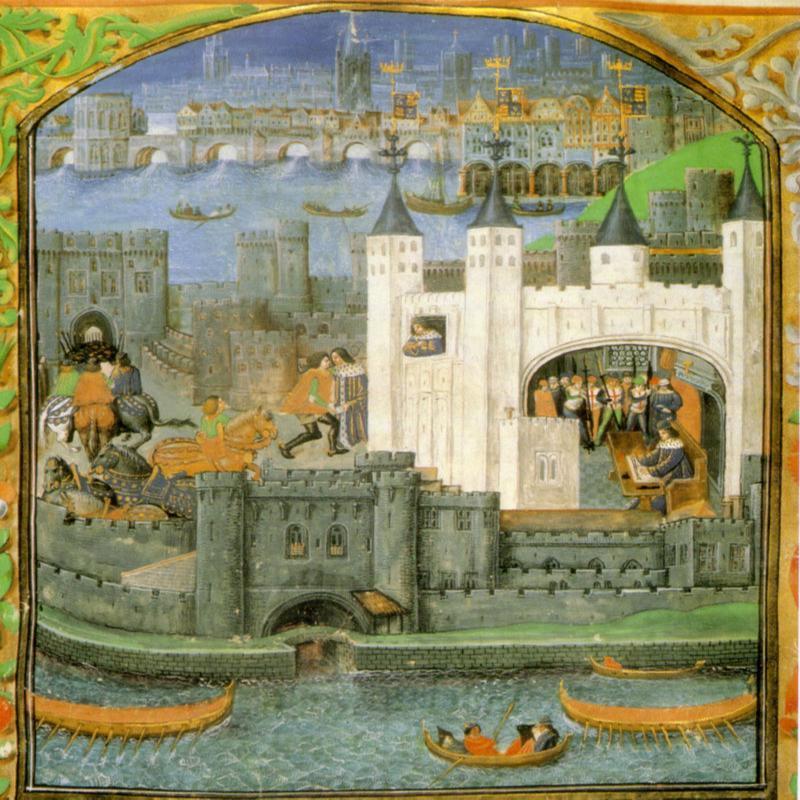
That night Richard from his position of safety within the Tower of London looked upon a city in flames as those responsible noisily and threateningly thronged below. He later convened a meeting of his Council. Some wanted to attack the rebels at once but Richard who could call upon some 600 archers and men-at-arms thought them too few and unreliable. Instead, he sided with those who counselled caution and it was agreed that couriers be sent to inform the rebels that he would meet with them at Mile End on the morrow.
Early the following morning as the rioting in the city subsided, Richard along with his entourage and a small escort (only a few soldiers had heeded the call to muster) made the perilous journey from the Tower to Mile End.
Jostled and harangued by the crowd violence hung in the air as the Royal Party made their way slowly towards their destination and a fate yet unknown. Upon arrival the rebels demanded the following of the King; the abolition of feudal obligation and an end to serfdom; the right to buy and sell on the market without interference; a rent limit of 4d an acre; an end to manorial fines; no forced labour; a free and full pardon for all those currently in a state of rebellion; and the execution of the men responsible for the imposition of the poll tax.
Much to the astonishment of all present Richard agreed to every one of the demands except that to hand over the 16 Lords of the Realm and Royal Officials including John of Gaunt and the powerful Duke of Lancaster for summary execution declaring that he who is found guilty of a crime will be punished subject to the law.
Disappointed that the men on their death list would be spared for now the rebels were no longer willing to take the King at his word and demanded he put his concessions in writing. Again, he agreed and 30 scribes were assigned to draw up the appropriate charters.
If Richard was merely seeking to divide and rule, then it worked for many of the rebels now departed for home but others remained not trusting the King to be faithful while his evil counsellors continued to stand at his right hand.
While the King was negotiating with the rebels at Mile End violence had once again broken out in London. News had leaked that both the hated Robert Hales and Simon Sudbury had taken refuge in the Tower of London which was now attacked. Although it was heavily guarded and should have been a place of safety someone had treacherously lowered the drawbridge and unlocked the gates. Hundreds of rebels flooded into the courtyard and began to rampage through the buildings as the troops assigned to its defence simply disappeared - the great dining area, the kitchens, the royal bedchambers, all were trashed and looted as the mob sought out the targets of their rage.
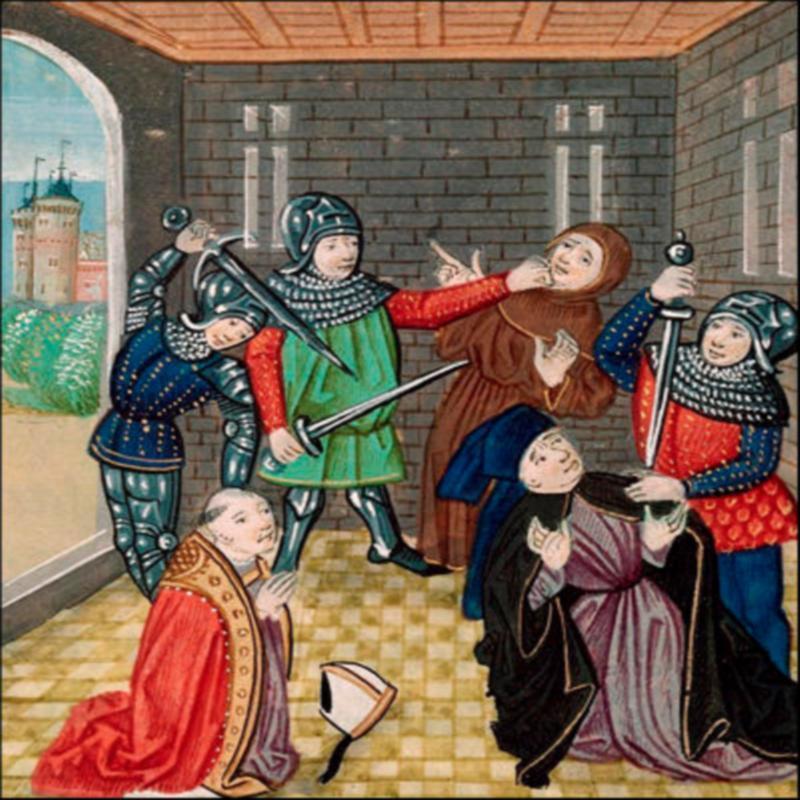
The King’s mother Joan of Kent was quickly spirited away but neither Hales nor Sudbury were so fortunate. They had fled to the White Tower, but it afforded them little protection. Despite Sudbury’s threat of interdiction should they be harmed and that the Wrath of God would be upon them he, Robert Hales, the Royal Physician William Appleton, and a guard John Legge were roughly dragged to Tower Hill and beheaded it taking seven swipes of the axe to decapitate the Archbishop of Canterbury.
Learning of the attack upon the Tower and informed that his mother was safe Richard was taken to the ‘Great Wardrobe,’ a fortified house in Blackfriars where he held an emergency meeting of the Royal Council. Panic was the watchword and the exchanges heated as both flight and abdication were discussed, and it seems that the young King was one of the few who kept a level head. He had bought valuable time at Mile End he told them and would do so again by meeting with the Kentish rebels at Smithfield - if what transpired thereafter was pre-planned we cannot know.
While the killing in London continued Richard was taken under cover of darkness to Westminster Abbey where he prayed before the shrine of Edward the Confessor.
The atmosphere at Smithfield was tense as the two camps lined up similar to opposing armies. The rebels though much diminished in number from before were still far greater than the forces available to the King and they were armed many with bows and halberds stolen earlier from the Tower of London. They were prepared to fight and as Wat Tyler rode out alone to meet with the King his guards formed a protective ring around him.
Tyler dismounted from his horse and strode confidently toward Richard, an evident swagger in his step before bowing unconvincingly shaking him by the hand and calling him brother, all the time nervously fingering the hilt of his dagger. He then made it plain that he was not satisfied with the concessions made at Mile End and that he had further demands that must be met; the money raised by the most recent poll Tax to be returned and redistributed; the entire nobility except for the King and his immediate heirs must be abolished; and John Ball is to be appointed as the new Archbishop of Canterbury. Richard agreed, and even the brash Tyler was stunned into momentary silence, before declaring himself parched on such a hot day and calling for a flagon of ale to slake his thirst, which he downed with alacrity before wiping his mouth in dismissive fashion and belching in the presence of the King.
Acknowledging that a deal had been struck Tyler remounted his horse and began to ride back toward his men. It was now that one of the King’s retinue, a young squire by the name of John Newton shouted out: “You are the greatest robber and thief in all of Kent and England.” Tyler drew his dagger and rounded on the young man at which point the Lord Mayor of London William Walworth, offended by Tyler’s lack of deference toward the King intervened and remonstrated angrily with him as the Royal Guards swarmed around to conceal events from the rebels looking on.
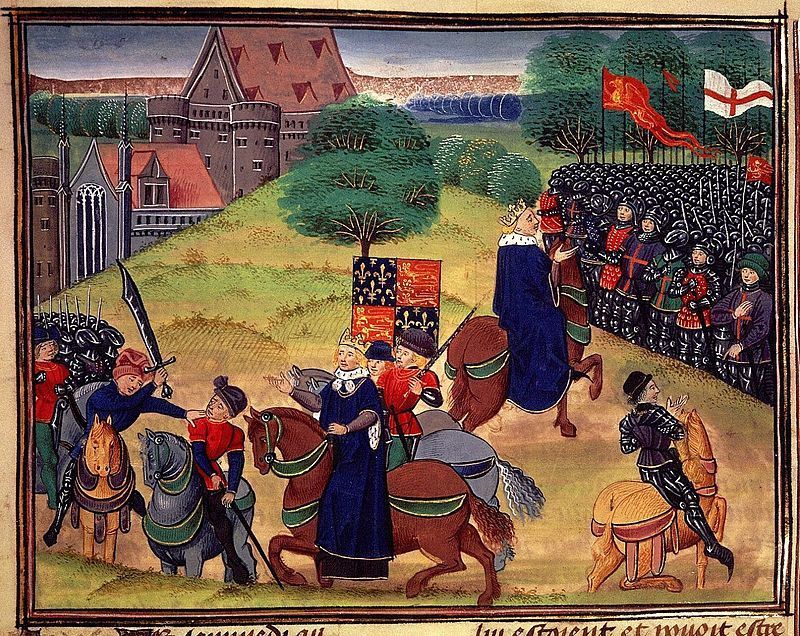
Tyler struck at Walworth, but the blow was deflected by the Mayor’s armour. Walworth then retaliated, striking Tyler in the neck and so the fight continued until struggling free of the melee Tyler kicked on toward his men calling on them to intervene, but he got no further than a hundred paces before he fell from his horse - the King’s men were upon him in an instant.
Had the rebels attacked the Plantagenet Monarchy may have ended there and then but it was the 14-year-old Richard who now seized the initiative as riding towards the rebels he shouted: “You shall have no Captain, but me.”
The words had been carefully chosen, their meaning deliberately ambiguous - was he now their leader or was it a reassertion of Royal authority? The rebels did not attack they remained passive, some even cheered. Richard now demanded that they follow him to Clerkenwell Fields. Some wandered away, but most did as they were told.
In the meantime, Tyler’s body had been carried off to nearby St Bartholemew’s Abbey from where it was later removed and decapitated the head being struck on a pole and taken to Clerkenwell where Richard was preparing to address the rebels. Reinforced by troops of the London Garrison who had earlier been too afraid to show their faces they now heard a very different King:
“You wretches detestable on land and sea, you who seek equality with Lords and are unworthy to live give this message to your colleagues; rustics you are and rustics you shall remain, you will remain in bondage, not as before but incomparably harsher; for as long as we live we will strive to suppress you and your misery will be an example in the eyes of posterity. However, we will spare your lives if you are faithful. Choose now which course you want to follow.”
As the Royal troops surrounded them and the King berated them for their treason the rebels discarded their arms, fell to their knees, and begged for mercy. The King’s concessions were now rescinded, and the charters drawn up burned, while law and order was restored by force. A rebellion that just days earlier had threatened to tear down the entire structure of society in medieval England would be crushed within weeks.
But even as the events in London unfolded to the rebels, detriment the revolt continued to spread in other parts of the country. In Suffolk rebels led by John Wrawe stormed the Abbey of Bury St Edmunds before hunting down and killing the hated Sir John Cavendish, Chief Justice of the King’s Bench; in Cambridge churches were burned and the esteemed College of Corpus Christi ransacked; the city of Norwich fell to the rebels with the local Justices put to the sword while similar acts of violence were reported as far north as Lincolnshire and Yorkshire.
In places where charters had been received, they were already being acted upon. In St Albans for example, where permission to demolish the Abbey had been granted, fences had been placed around it, prisoners released from its dungeons, and documents were being burned in its courtyard.
But the newly resurgent Royal Authority would crush all dissent without equivocation and little if any compassion, but news of Wat Tyler’s death travelled slowly.
On 28 June, the Essex rebels who had not yet dispersed were cornered at Billiericay by the Royal Army of Sir Thomas of Woodstock and defeated in a pitched battle that left more than 500 of them dead with the survivors receiving little succour from the local population who now wanted nothing to do with them. The Peasants’ Revolt no longer had the support of the peasants as was made clear when the King’s call for volunteers to crush it was heeded in great numbers by those who had previously participated in it but were now desperate to prove their loyalty. The last significant engagement occurred at North Walsham in Norfolk where loyal troops under Henry le Dispenser, the Bishop of Norwich, defeated a rebel army led by Geoffrey Lister.
By the end of June, it was all over and the retribution began, thousands of rebels had already been killed in fighting and acts of arbitrary violence now it was the turn of the Courts to bring justice where order had already been restored. John of Gaunt was particularly eager to bring to account those responsible for destroying his London residence and retrieving what of his treasure remained but he was to be largely thwarted in both.
John Ball had escaped the events at Smithfield and fled north but was too well known a figure to remain at liberty for long and on 11 July was arrested near Coventry. Returned to St Albans he was tried for treason. In his testimony to the Court, he neither denied his involvement in the revolt nor recanted his religious beliefs. Found guilty he was hung, drawn, and quartered in the presence of the King. His skewered head was then displayed upon London Bridge while his four quarters were likewise distributed among nearby towns.
Just a month after the start of the rebellion he had done so much to provoke Thomas Baker was similarly hunted down and executed; the renegade soldier Thomas Wootton was arrested following Smithfield and chose trial by combat over trial by jury - he lost.
In the months following the restoration of peace Richard travelled the country accompanied by a large army, where, going from town to town he promised no further retribution where a willingness was shown to indicate who among them were the ringleaders of the revolt.
Besides the thousands who were punished in the immediate aftermath of the Peasant’s Revolt many others simply melted back into society; the wine merchant John Mocking returned to his business selling the finest victuals to the wealthy of London among them John of Gaunt; John and Joan Ferrour returned home with their booty where they were generous to their friends; Richard Scott was arrested many times in the years to come but for theft and fraud never treason.
The Peasants’ Revolt, the most serious threat ever posed to the status quo in England had been suppressed but no less important for the future of the Monarchy and the maintenance of the social order was that it should be quickly forgotten – and so it was.
Tagged as: Ancient & Medieval
Share this post:





